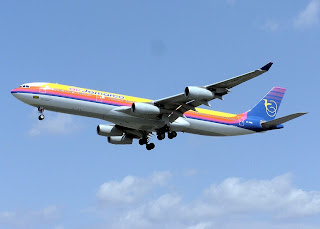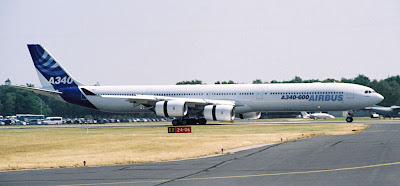 The Airbus A340 is a long-range four-engined widebody commercial passenger airliner manufactured by Airbus S.A.S. a subsidiary of EADS. It is similar in design to the twin-engined A330. The first published studies for the A340 were as the TA11 in 1981, as shown in the November issue of Air International (coinciding with the display of the A300 at that year's Farnborough Air Show). Concept drawings of the A320 (SA 9) and A330 (TA9) were also published, along with estimated performance figures by Airbus Industrie.
The Airbus A340 is a long-range four-engined widebody commercial passenger airliner manufactured by Airbus S.A.S. a subsidiary of EADS. It is similar in design to the twin-engined A330. The first published studies for the A340 were as the TA11 in 1981, as shown in the November issue of Air International (coinciding with the display of the A300 at that year's Farnborough Air Show). Concept drawings of the A320 (SA 9) and A330 (TA9) were also published, along with estimated performance figures by Airbus Industrie.
The A340 was launched in June 1987 as a long-range complement to the short-range A320 and the medium-range A300. At the time, Airbus's twinjets were at a disadvantage against aircraft such as the Boeing 747 because of the ETOPS problem: two-engined aircraft had to stay within close range of emergency airfields to allow for engine malfunction.
The A340 was designed in parallel with the twin-engined A330: both aircraft share the same wing and similar fuselage structure, and borrow heavily from the advanced avionics developed for the A320. Both the A330 and A340 are assembled on the same final assembly line at Toulouse-Blagnac, France. The four-engined A340 is able to fly long over-water routes. Because of its ETOPS-immunity, Virgin Atlantic Airways used the motto "4 Engines 4 Long Haul," on its A340 fleet. Lufthansa A340-600
Lufthansa A340-600
It was originally intended to use the new superfan engines of IAE (International Aero Engines) in the A340 but IAE decided to stop their development and the CFMI CFM56-5C4 was used instead. When the A340 first flew in 1991, engineers noticed a potentially major design flaw in the first model: the wings were not strong enough to carry the outboard engines at cruising speed without warping and fluttering. To alleviate this, an underwing bulge called the plastron, named after the undershell of a tortoise, was developed to correct airflow problems around the engine pylons. The modified A340 began commercial service in 1993 with Lufthansa and Air France. The A340 incorporates high-technology features such as fully digital fly-by-wire flight control system. It also uses a sidestick controller instead of normal control columns. There is one 'joystick' to the left of the pilot and one to the right of the co-pilot. The A340, as with all Airbus planes, employs a common pilot rating, specially with the two-engined A330. The cockpit also features CRT-based glass cockpit displays on the A340-200 and A340-300 and LCD-based on -500 and -600. Some composite primary structures are also used.
The A340 incorporates high-technology features such as fully digital fly-by-wire flight control system. It also uses a sidestick controller instead of normal control columns. There is one 'joystick' to the left of the pilot and one to the right of the co-pilot. The A340, as with all Airbus planes, employs a common pilot rating, specially with the two-engined A330. The cockpit also features CRT-based glass cockpit displays on the A340-200 and A340-300 and LCD-based on -500 and -600. Some composite primary structures are also used.
When fuel costs rose, airlines began looking at the Boeing 777 as an alternative to the A340. As the years went by, orders for the 777 rose, while orders for the A340 diminished. It can be argued that, with modern engines having extremely low failure rates (as seen in the ETOPS certification of most twinjets) and increased power output, four engines are no longer necessary except for very large aircraft, such as the Airbus A380 or Boeing 747. In 2005, Airbus had only 15 orders for the A340. A340-600 at the Farnborough Air Show, 2006
A340-600 at the Farnborough Air Show, 2006
In January 2006, Airbus announced plans to develop an enhanced version of the A340, dubbed the A340E; where E stands for enhanced, because of disappointing sales in the wake of newer longer range Boeing 777s in 2005, and the rise in fuel costs that have justified twin-engine planes as being more economical to operate than four engine planes. Airbus claims that the enhanced A340 will be more fuel-efficient than earlier A340s and will allow the model to compete more effectively with the Boeing 777. When this possible model will be developed has yet to be determined. BWIA Airbus A340-300, 9Y-TJN, in 2002
BWIA Airbus A340-300, 9Y-TJN, in 2002
Source: Wikipedia
June 17, 2007
Airbus A340
Labels: Aircraft List
Subscribe to:
Post Comments (Atom)






No comments:
Post a Comment